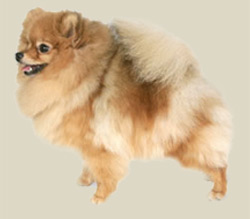
Country of Origin: Germany
Group: Spitz and Primitive types
Section: European Spitz
Original Function: companion
Todays Function: companion
Dimension Male: 18-30 cm
Dimension Female: 18-30 cm
Weight Male: 1-3 kg
Weight Female: 1-3 kg
Litter Size: 1-2 puppies, often require Cesarean sections
Life span: 12-16 years
Other Names: Zwergspitz, Dwarf Spitz, Loulou, Pom
Colors: All patterns and colors are acceptable, including black and tan, brindle, parti-color, and solid col
Living: Pomeranians are perfectly suited to indoor living, and will even do quite well in an apartment. they
Recognized: CKC, AKC, UKC, KCGB, CKC, ANKC, NKC, NZKC, CCR, APRI, ACR
Description
The Pomeranian is a tiny, fluffy dog with a wedge-shaped head and pointed erect ears. Some have faces that breeders liken to a fox; others have baby-doll or "pansy" faces. All have bright, dark, almond-shaped eyes with an intelligent expression. The nose is either dark or the color of its coat. The teeth should meet in a scissors bite. Poms also boast a distinctive feathered tail that fans forward over the back. There is an abundant ruff around the neck and chest area. The profuse stand-off double coat usually comes in solid colors. Any solid color is allowed, but the most common are red, orange, white or cream, blue, brown or black. Sometimes the coat is parti-colored (white with colored markings), black & tan, wolf or orange sable.
Temperament
Bouncy, bold and busy, the Pomeranian makes the most of every day. It is curious, playful, self-confident (even cocky) and attentive, ever ready for a game or adventure. It is reserved toward strangers. Some can be aggressive toward other dogs. Some bark a lot.
Excercise
The Pomeranian is active but diminutive, needing daily exercise but able to meet its needs with indoor games or short walks. Although it has a warm coat, it is too small and too family-oriented to live as an outdoor dog. Its double coat needs brushing twice weekly, more when shedding.
Grooming
The Pomeranian"s very long, double coat should be brushed frequently. If you work from the head, parting the coat and brushing it forward, it will fall neatly back in place, so the task, although time-consuming, is relatively easy. The cottony undercoat i
Health
Major concerns: patellar luxation
Minor concerns: open fontanel, hypoglycemia, shoulder luxation, PRA, entropion
Occasionally seen: tracheal collapse, PDA
Suggested tests: knee, eye, (cardiac)
Click here to ORDER this PUPPY
